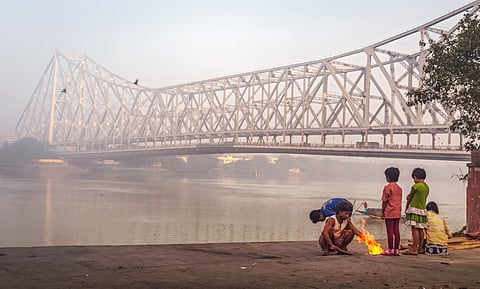

A new study by Kolkata-based Bose Institute found that the toxicity of PM 2.5 — ultrafine particulate matter — rose sharply when pollution levels crossed 70 micrograms per cubic metre of air. The research, published in the international journal Science of the Total Environment in October 2024, was recently cited by the Union government’s Press Information Bureau (PIB).
“A new study conducted in Kolkata shows that the toxicity value of PM2.5 experiences a sudden jump when the pollution reaches around 70 microgrammes per cubic metre (µg/m³),” the PIB note stated. The toxicity continues to rise until around 135 µg/m³, before stabilising, it added. The findings were based on a long-term analysis of air quality data of the city collected between 2016 and 2023.
India’s national air quality standard sets a 24-hour average limit of 60 µg/m³ for PM2.5. However, from October to February — the winter months when pollution typically peaks — this threshold was exceeded to 70 µg/m³ on nearly 75 per cent of the days in Kolkata’s metropolitan area, said professor Abhijit Chatterjee, the study’s lead researcher.
PM 2.5 particles, with a diameter of 2.5 micrometres or smaller, can penetrate deep into the respiratory system and are linked to various health issues including asthma, chronic obstructive pulmonary disease, cardiovascular complications and pulmonary fibrosis. PM 2.5 levels are also a key indicator of air quality of any area.
The study, Contrasting features of winter-time PM2.5 pollution and PM2.5-toxicity based on oxidative potential: A long-term (2016–2023) study over Kolkata megacity at eastern Indo-Gangetic Plain, was co-authored by Chatterjee and doctoral researchers Abhinandan Ghosh and Monami Dutta.
The team found that during the study period, PM2.5 concentrations often exceeded permissible limits by several times — the highest recorded level being seven times above the standard. The study focused on sampling sites in eastern Kolkata near the EM Bypass, as well as in the city’s northern and southern zones.
“When PM2.5 levels exceed around 70 µg/m³, their potential to cause oxidative stress (a process that can damage human cells) increases rapidly,” Chatterjee explained told this author in an exclusive chat. “This is mainly due to certain chemical components released by biomass and solid waste burning. Vehicular emissions contribute as well, though to a lesser extent.”
The study indicates that the rise in toxicity is linked to a specific threshold. “The steep increase continues until PM2.5 levels reach around 130 to 140 µg/m³, after which the toxicity stabilises,” the researcher explained. Chatterjee also noted that the study was conducted only during winter, as PM2.5 pollution tends to peak during that season.
High levels of harmful molecules like peroxides, hydroperoxides and hydroxyls can cause cellular damage and increase the risk of lung problems such as chronic obstructive pulmonary disease, asthma, pulmonary fibrosis and other types of inflammation. “Oxidative stress is mainly associated with the pulmonary malfunction,” the paper said.
The findings also brought up the efficacy of the National Clean Air Programme (NCAP), launched in 2019 to tackle pollution in India's most affected cities. Despite hundreds of crores spent under the initiative, Kolkata saw little reduction in PM2.5 pollution from biomass and waste burning, even as emissions from vehicles, industries and road dust showed significant declines. The city utilised over Rs 636 crore from NCAP funds between 2019 and 2023.
“Before NCAP was implemented, the 70 µg/m³ barrier was breached in 80-85 per cent of winter days,” said a scientist associated with the study. “After NCAP implementation, that figure came down slightly to about 65-72 per cent — still nearly three-fourths of the season.”
There were major declines in emissions from vehicles (33 per cent), industries (39 per cent) and road dust (42 per cent) during the post-NCAP period. “However, no significant change is observed for biomass burning emissions,” read the paper.
The research highlighted that ongoing use of biomass for cooking and open-air burning, without proper oversight or regulation, remains a major driver of sustained air toxicity. “The massive use of biomass as conventional cooking fuel by the poor and underprivileged because of the unaffordable high refilling cost of (LPG), and the burning of dry leaves in winter morning and evening are the major and frequent practices across the city that remained beyond proper surveillance and control,” the researchers wrote in the paper.